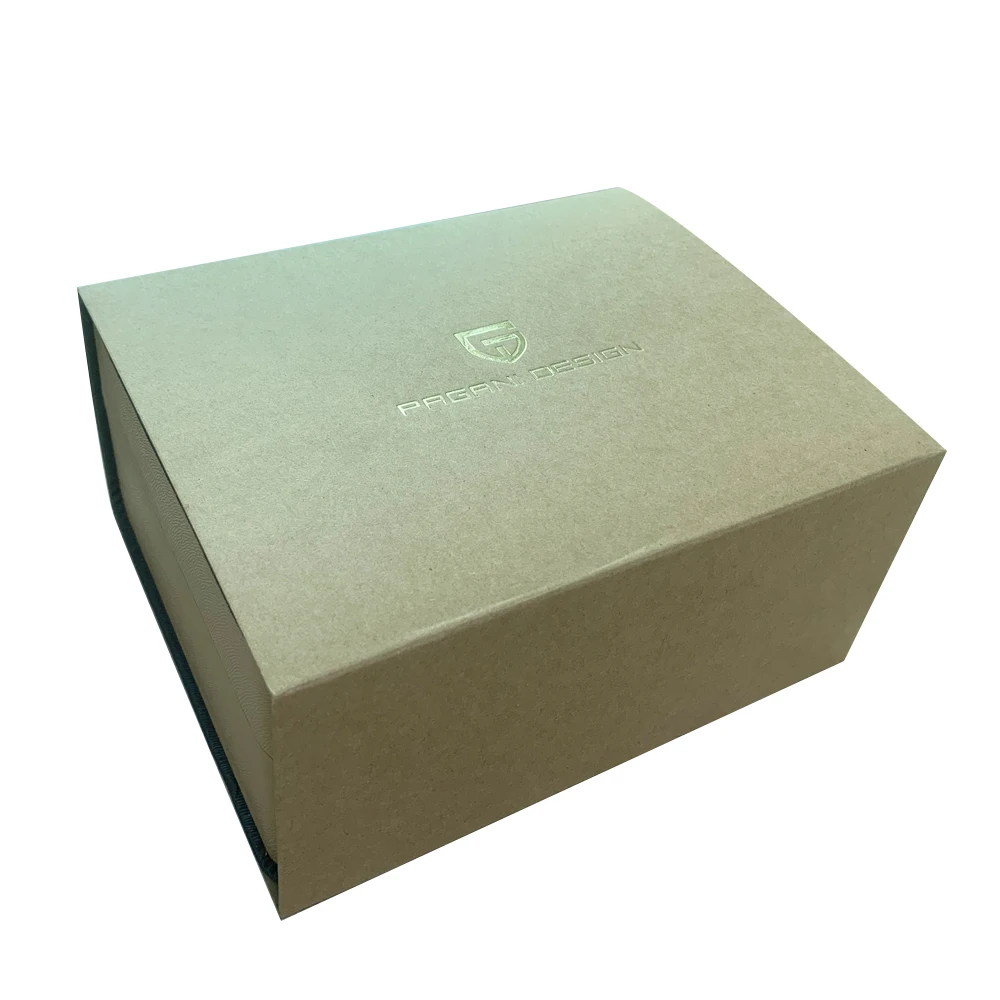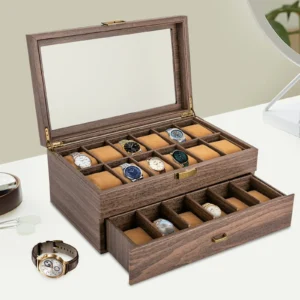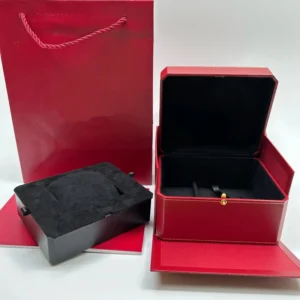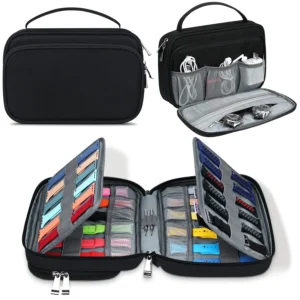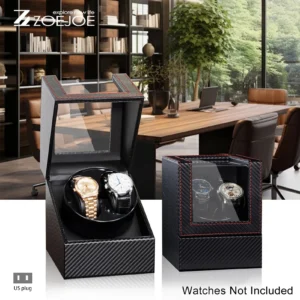The Importance of Proper Care for Leather Watch Boxes
A premium leather watch box is more than just a storage container—it’s an investment that complements your fine timepiece collection. Like the watches themselves, these elegant leather boxes deserve specialized attention to maintain their beauty and functionality over time.
With proper care, a high-quality leather watch box can last for decades, serving as both a protective case and a distinguished display piece. The rich patina that develops on well-maintained leather creates character and depth that only improves with age. Conversely, neglected leather can become dry, cracked, and discolored—transforming from luxurious to lackluster.
Many collectors make the mistake of using generic household cleaners on their leather watch boxes. These products often contain harsh chemicals that strip away leather’s natural oils, causing premature aging and potential damage. Different leather types—from full-grain to bonded leather—each require specific approaches to cleaning and conditioning.
This comprehensive guide will walk you through everything you need to know about properly caring for your leather watch box. From identifying your leather type to selecting appropriate cleaning products and establishing a maintenance routine, we’ll help you preserve your investment for years to come. Understanding proper caring leather watch cases techniques is essential for maintaining both function and aesthetics of your leather watch boxes collection.
Understanding Different Leather Types in Watch Boxes
Before selecting cleaning products, it’s crucial to identify what type of leather your watch box features. Different leather varieties respond differently to cleaning methods and products.
Full-Grain Leather
Full-grain represents the highest quality leather available. It uses the entire top layer of the hide with all natural grain intact. These watch boxes showcase natural markings, possess exceptional durability, and develop a beautiful patina over time. Full-grain leather requires gentle cleaning and regular conditioning to maintain its character.
Top-Grain Leather
Slightly less expensive than full-grain, top-grain leather has had its surface sanded to remove imperfections. While still high quality, it’s thinner and more pliable. Top-grain leather watch boxes have a more uniform appearance and good durability, though they won’t develop the same distinctive patina as full-grain. They typically require regular but moderate conditioning.
Genuine Leather
Despite its name suggesting authenticity, genuine leather actually represents a lower quality grade. It’s made from the layers remaining after top-grain leather has been separated from the hide. Watch boxes made with genuine leather are more affordable but less durable and may require more frequent conditioning to prevent drying and cracking.
Bonded Leather
Bonded leather consists of leather scraps and fibers bonded together with adhesives. It’s the least expensive option and most susceptible to damage. Watch boxes made with bonded leather need gentle cleaning products and may deteriorate faster despite proper care.
Specialty Leathers
Some premium watch boxes feature specialty leathers like buttery-soft Nappa or textured suede and nubuck. These require particularly specialized care approaches, with suede and nubuck needing specific brushes and cleaners that won’t compress their raised fibers.
Understanding the subtle differences between leather aging watch boxes explained helps collectors make informed decisions about maintenance. Many watch enthusiasts compare wood leather watch box comparison options before deciding which material best suits their collection’s needs.
| Leather Type | Appearance | Durability | Cleaning Sensitivity | Recommended Cleaning Frequency |
|---|---|---|---|---|
| Full-Grain | Natural markings, develops patina | Excellent | Moderate | Every 3-4 months |
| Top-Grain | Uniform, smooth | Very Good | Moderate | Every 3-4 months |
| Genuine | Somewhat uniform, less distinctive | Good | High | Every 2-3 months |
| Bonded | Very uniform, may look artificial | Fair | Very High | Every 1-2 months |
| Nappa | Extremely soft, luxurious | Good | High | Every 3-4 months |
| Suede/Nubuck | Fuzzy, textured surface | Good | Very High | Monthly (light brushing) |
Essential Tools for Leather Watch Box Maintenance
Before diving into cleaning products, assemble these essential tools for proper leather care:
Microfiber cloths – Use high-quality, lint-free microfiber cloths specifically for leather care. Keep separate cloths for applying cleaners and conditioners to prevent cross-contamination. Avoid terry cloth or paper towels, which can leave lint or scratch delicate leather.
Soft-bristled brush – A horsehair brush is ideal for gentle dust removal without scratching leather surfaces. Synthetic alternatives can work well too, but ensure bristles are soft and non-abrasive.
Vacuum with brush attachment – For interior cleaning, a small vacuum with soft brush attachment helps remove dust and debris from crevices without abrasion.
Cotton swabs – Perfect for cleaning tight corners, hardware surrounds, and other detailed areas where cloths can’t reach effectively.
Clean bowl – For mixing DIY cleaning solutions or holding small amounts of commercial cleaner during application.
Store these tools in a clean, dry place separate from other household cleaning supplies to prevent contamination with harsh chemicals. Using dedicated leather cleaning tools extends both their effectiveness and the life of your watch box.
For comprehensive watch care, explore additional watch accessories that complement your maintenance routine.
Best Leather Cleaners for Watch Boxes
When selecting cleaning products for your leather watch box, pH balance is paramount. Leather naturally maintains a slightly acidic pH level between 4.5 and 5.5. The best cleaners maintain this delicate balance rather than disrupting it with alkaline formulations.
pH-Neutral Leather Cleaners
These specialized formulations are designed to clean without altering leather’s natural chemistry. They remove surface dirt while respecting the material’s pH balance, preserving essential natural oils that keep leather supple. Look for products specifically labeled “pH-balanced” or “pH-neutral” for optimal results.
Foaming Cleaners
Leather foaming cleaners offer several advantages for watch box maintenance:
* The foam consistency prevents over-saturation of the leather
* Foam stays on the surface rather than soaking in excessively
* Effective for lifting dirt from leather grain without aggressive scrubbing
Apply foam cleaners with a slightly damp cloth using gentle circular motions, then wipe away residue with a clean, dry cloth. These work particularly well on smooth leather finishes.
Gel Cleaners
Gel formulations provide controlled application for more thorough cleaning:
* Thicker consistency allows longer contact time with stubborn spots
* Ideal for textured leather surfaces where dirt can accumulate in grain patterns
* Provides deeper cleaning for more soiled areas
Apply a small amount to a cloth (never directly to the leather), work into the surface with gentle motions, then thoroughly remove any residue with a clean cloth.
Spray Cleaners
Spray leather cleaners offer convenience but require careful application:
* Always spray onto a cloth, never directly onto the leather
* Provide even distribution of cleaning agents
* Work well for regular, light maintenance cleaning
These are best suited for lightly soiled watch boxes needing refreshment rather than deep cleaning.
DIY Options
For very light cleaning, a solution of distilled water and a few drops of mild, dye-free soap can work in a pinch. However, this approach comes with significant caveats:
* Mix sparingly—excessive water damages leather
* Test in an inconspicuous spot first
* Dry thoroughly to prevent water damage
* Not recommended for suede or unfinished leather
Commercial leather cleaners are generally safer and more effective for valuable watch boxes.
Ingredients to Look For and Avoid
Beneficial ingredients:
* Lanolin or jojoba oil (in small amounts)
* Natural surfactants
* Glycerin
Ingredients to avoid:
* Alcohol (drying)
* Ammonia (damages dye and fibers)
* Petroleum distillates (can cause premature aging)
* Strong detergents
* Silicone (blocks leather’s ability to “breathe”)
Different leather types require specific approaches to cleaning. For example, aniline leather (fully dyed, showing natural markings) demands extremely gentle cleaners, while pigmented leather (coated with polymer and color) tolerates slightly more robust cleaning. Understanding how clean leather watch cases properly ensures your cleaning regimen enhances rather than damages your investment.
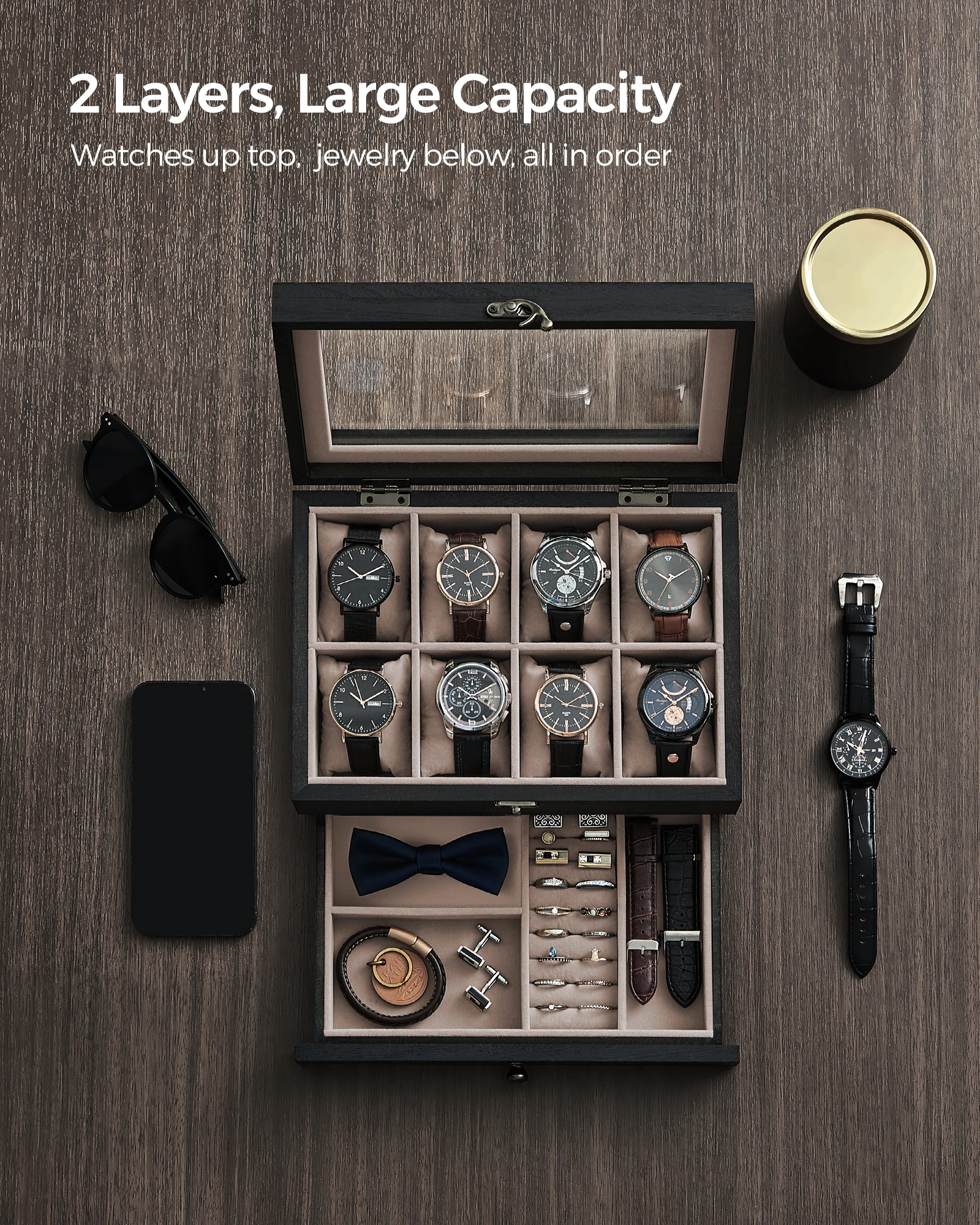
Leather Conditioners and Protectants
Cleaning is only half the battle in maintaining leather watch boxes. Conditioning is equally crucial for long-term preservation, as cleaning removes not just dirt but some of leather’s natural oils. Without replenishment through conditioning, leather gradually dries out, losing flexibility and developing cracks.
Types of Leather Conditioners
Cream-based conditioners:
* Provide thorough, deep conditioning
* Work well on thicker, sturdier leather types
* Offer longer-lasting results
* Generally better for older leather that’s showing signs of dryness
Oil-based conditioners:
* Penetrate deeply into leather fibers
* Excellent for very dry or neglected leather
* Can darken some leather types (test in inconspicuous area first)
* Require careful application to prevent oversaturation
Many leather enthusiasts question should you oil leather watch boxes, and the answer depends largely on the specific leather type and condition. Generally, cream conditioners provide safer options for most watch boxes, while oils may be beneficial for particularly dry or neglected pieces.
Leather Protectants
Beyond conditioning, protective products offer additional benefits:
* UV inhibitors shield leather from sun damage and fading
* Water-repellent formulations prevent water spots and potential staining
* Some products combine conditioning and protection functions
For watch boxes kept in variable environments, protectants provide valuable insurance against environmental damage.
Application Guidelines
Conditioning frequency depends on several factors:
* Environmental conditions (drier climates require more frequent conditioning)
* Usage patterns (frequently handled boxes need more conditioning)
* Storage location (exposure to sunlight or heating/cooling vents)
Most watch boxes benefit from conditioning 2-4 times yearly. Watch for these signs that conditioning is needed:
* Leather feels dry or stiff to the touch
* Loss of natural luster or sheen
* Slight fading or lightening of color
* Minor surface cracking beginning to form
Caution: Over-conditioning is as problematic as under-conditioning. Excessive product application can saturate leather, making it greasy, attracting dirt, and potentially causing breakdown of the fibers. Always apply conditioners sparingly, working gradually with thin layers rather than one heavy application.
Step-by-Step Cleaning Process for Leather Watch Boxes
Follow this methodical approach for best results when cleaning your leather watch box:
1. Preparation
- Remove all watches and contents completely
- Place box on a clean, flat work surface
- Ensure good lighting to see all areas clearly
- Cover surrounding surfaces to protect from potential product transfer
- Gather all necessary cleaning supplies before beginning
2. Patch Test
- Apply a small amount of your chosen cleaner to an inconspicuous area
- Allow it to sit for 5-10 minutes
- Check for any adverse reactions like discoloration or texture changes
- Proceed only if no negative reaction occurs
3. Dusting and Debris Removal
- Use soft brush to gently remove surface dust from exterior
- Pay special attention to seams and corners where dust accumulates
- For interiors, use vacuum with brush attachment on low power
- Brush in the direction of any visible grain pattern
4. Spot Cleaning
- Address fingerprints and minor marks first
- Apply cleaner to cloth (never directly to leather)
- Gently dab at spots rather than rubbing aggressively
- Allow each area to dry slightly before assessing if another application is needed
5. General Cleaning
- Work in small sections of about 4-6 inches at a time
- Apply cleaner in gentle circular motions for smooth leather
- For embossed or textured leather, follow the grain pattern
- Use minimal pressure—let the cleaner do the work
- Remove residue immediately with a clean, dry cloth
- Never oversaturate the leather; the cloth should be damp, not wet
6. Drying
- Allow box to air dry naturally at room temperature
- Keep away from direct sunlight, heaters, hair dryers, or other heat sources
- Ensure complete drying before conditioning (typically 1-2 hours minimum)
- Leave box open to allow interior to dry thoroughly
7. Conditioning
- Apply conditioner sparingly to a clean cloth
- Work in very thin layers using gentle circular or straight motions
- Apply more product to areas that receive more handling
- Allow conditioner to absorb for the time recommended on the product (typically 10-30 minutes)
- If leather seems to need more conditioning, apply additional thin layers rather than one thick application
8. Final Buffing
- Using a clean, dry microfiber cloth, gently buff the entire surface
- This removes excess product and enhances the natural luster
- Use light pressure in circular motions
- Pay special attention to any areas where product may have built up
For ongoing maintenance, incorporating regular leather watch box maintenance tips into your collection care routine will preserve both functionality and appearance.
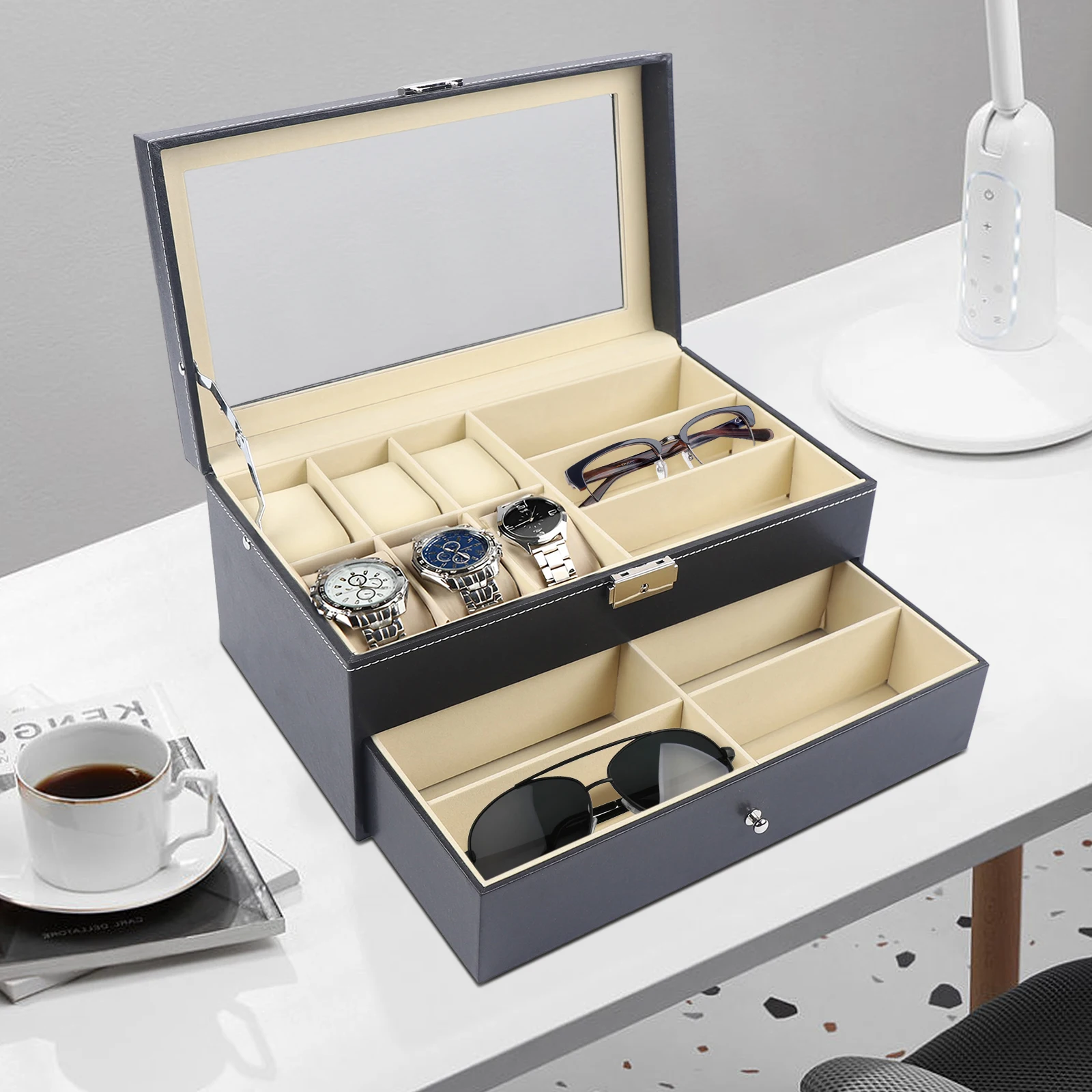
Addressing Common Leather Problems and Stains
Even with careful handling, leather watch boxes may develop various issues over time. Here’s how to address common problems:
Light Scuffs
Light surface scuffs often affect only the finish rather than the leather itself:
* Gently buff with a soft cloth, which may redistribute the finish
* For persistent scuffs, apply a tiny amount of conditioner with your fingertip
* Work in circular motions, then buff with a clean cloth
* For colored leather, ensure any product is color-neutral or color-matched
Water Spots
Water spots occur when droplets dry on leather, leaving mineral deposits:
* Slightly dampen a cloth with distilled water
* Gently wipe the entire panel (not just the spot) to blend
* Allow to dry naturally, then condition the area
* For prevention, quickly blot (don’t rub) any water that contacts your watch box
Oil or Grease Marks
Oil marks can be particularly troublesome on leather surfaces:
* Blot excess oil immediately without rubbing
* Sprinkle plain cornstarch or talcum powder on the area
* Allow to sit for several hours (preferably overnight) to absorb oil
* Brush away powder gently, then clean normally if needed
* Severe oil stains on valuable boxes may require professional treatment
Ink Stains
Ink presents one of the most challenging stains for leather:
* Act immediately—fresh ink responds better to treatment
* Blot (don’t rub) with a dry cloth to remove excess
* Commercial ink removers designed for leather may help with fresh stains
* Never use alcohol-based products, which damage leather
* Be aware that many ink stains become permanent; professional help may be needed
Fading or Color Transfer
Leather boxes exposed to sunlight or dye transfer from other items may show color changes:
* Prevention is key—keep boxes away from direct sunlight
* For minor fading, conditioning often improves appearance
* Color transfer sometimes responds to gentle leather cleaner
* Significant color issues generally require professional restoration
For valuable collections, investing in luxury watch boxes with quality leather that resists common problems provides better long-term protection for your timepieces.
What to Avoid When Cleaning Leather Watch Boxes
Protecting your leather watch box requires knowing what products and techniques to avoid:
Harmful Chemicals and Solutions
- Alcohol-based products – Dehydrate leather, causing stiffness and cracking
- Ammonia and bleach – Destroy leather’s protein structure and remove dyes
- Acetone and harsh solvents – Dissolve finishes and damage leather fibers
- Household all-purpose cleaners – Contain detergents too harsh for leather
- Furniture polish with silicones – Create buildup and prevent leather from breathing
- Vinegar – Despite DIY recommendations, its acidity damages leather over time
- Shoe polish – Contains dyes and waxes unsuitable for watch boxes
Damaging Cleaning Techniques
- Over-saturating the leather – Excess moisture leads to water damage and warping
- Aggressive scrubbing – Abrades surface finishes and damages grain patterns
- Using abrasive materials – Paper towels, rough cloths, and scouring pads scratch leather
- Applying excessive product – Creates buildup that attracts dirt and clogs leather pores
- Steam cleaning – Heat and excess moisture cause shrinkage and damage
- Drying with heat – Hair dryers, heaters, or direct sunlight cause drying and cracking
- Allowing stains to set – Delayed response makes stains more difficult to remove
Environmental Factors Affecting Leather Watch Boxes
Your leather watch box’s longevity depends not just on cleaning but also on its environment. Understanding and controlling these factors significantly extends your box’s life.
Optimal Storage Conditions
Leather thrives in stable, moderate environments. The ideal storage conditions include:
* Temperature between 65-75°F (18-24°C)
* Relative humidity between 40-60%
* Good air circulation
* Storage away from exterior walls (which may develop condensation)
Sunlight and UV Exposure
Direct sunlight causes significant damage to leather:
* Fading and discoloration occur relatively quickly
* UV rays break down leather fibers over time
* Heat from sunlight causes drying and potential warping
* Store boxes away from windows or use UV-filtering window films
Temperature Fluctuations
Stable temperatures preserve leather’s integrity:
* Extreme heat causes leather to dry and potentially crack
* Cold environments may make leather brittle
* Rapid temperature changes stress leather fibers
* Avoid placing watch boxes near heating vents, radiators, or air conditioners
Humidity Considerations
Proper humidity balance is crucial:
* Too dry: leather loses moisture and becomes brittle
* Too humid: encourages mold growth and potential warping
* Consider room humidifiers or dehumidifiers if your storage area has extreme conditions
* Silica gel packets can help control moisture in closed watch boxes
Learn more about effectively protecting leather watch cases moisture to prevent environmental damage that necessitates more intensive cleaning.
Regular Maintenance Schedule
Establishing a consistent care routine prevents major cleaning challenges and preserves your watch box’s condition:
| Frequency | Maintenance Tasks | Time Required |
|---|---|---|
| Weekly | Dust exterior with soft cloth Remove fingerprints Check for new spots or stains | 5 minutes |
| Monthly | Inspect interior and exterior thoroughly Spot clean as needed Dust hardware and crevices Vacuum interior gently | 15 minutes |
| Quarterly | Full cleaning with leather cleaner Apply conditioner after cleaning Check hinges and closures Inspect for early signs of wear | 30-45 minutes |
| Bi-annually | Apply leather protectant Deep clean interior Condition all leather surfaces Check structural integrity | 45-60 minutes |
Adjust this schedule based on:
* Usage frequency (display boxes vs. storage boxes)
* Environmental conditions (dry, humid, or variable environments)
* Visible signs of need (dullness, dryness, or soil)
Your maintenance routine should be more frequent if your watch box shows these signs:
* Surface appears dull or dry
* Leather feels stiff or inflexible
* New spots or stains appear
* Box is exposed to variable conditions or direct sunlight

Interior Care for Watch Box Linings
While exterior leather gets most attention, interior linings require specific care approaches:
Velvet Lining Care
Velvet interiors need gentle treatment:
* Use soft brush attachment on vacuum at lowest setting
* For spot cleaning, dampen cloth with water only and squeeze nearly dry
* Blot rather than rub to avoid crushing the pile
* Allow to dry completely before replacing watches
* For stubborn spots, consult professional cleaners
Suede Interior Maintenance
Suede linings respond well to these techniques:
* Use special suede brush or clean, dry toothbrush for gentle brushing
* Brush in one direction to maintain nap
* For light soiling, a pencil eraser can lift away marks
* Avoid all liquid cleaners on suede if possible
* Use commercial suede cleaner only for serious stains
Silk or Satin Lining
These delicate fabrics require minimal intervention:
* Spot clean with cloth barely dampened with water
* Allow to air dry completely
* Never rub vigorously
* Consider professional cleaning for significant stains
* Prevent transfer by ensuring watches are clean before storage
Addressing Odors
Interior odors can develop over time:
* Air out box completely for 24-48 hours
* Place baking soda in small container inside box overnight, then remove
* Avoid commercial air fresheners which may transfer chemicals
* Cedar blocks can help absorb odors (keep them from direct contact with watches)
* Persistent odors may require professional treatment
For additional organization solutions that keep your timepieces safely arranged, explore our selection of watch organizer options that complement your leather watch box.
Watch Accessories, Watch Holder
$94.51 Select options This product has multiple variants. The options may be chosen on the product pageLuxury Watch Boxes, Men's Watch Boxes, Single Watch Box
Price range: $903.35 through $980.97 Select options This product has multiple variants. The options may be chosen on the product pageMen's Watch Organizer, Watch Display Case, Watch Organizer
Price range: $112.68 through $169.45 Select options This product has multiple variants. The options may be chosen on the product pageLuxury Watch Boxes, Luxury Watch Travel Case
Price range: $200.33 through $224.57 Select options This product has multiple variants. The options may be chosen on the product pageWatch Organizer, Watch Roll Travel Case
Price range: $88.39 through $99.36 Select options This product has multiple variants. The options may be chosen on the product pageAutomatic Watch Winder, Double Watch Winder, Leather Watch Boxes
$147.60 Select options This product has multiple variants. The options may be chosen on the product page
Is DIY Cleaning Always Appropriate?
While regular maintenance falls within most collectors’ capabilities, certain situations warrant professional intervention:
When to Seek Professional Care
- Vintage or antique leather boxes with historical value
- Severe staining that resists gentle cleaning attempts
- Water damage that has caused warping or interior damage
- Mold or mildew development
- Structural damage affecting the box’s integrity
- Rare or exotic leather types requiring specialized knowledge
- Valuable boxes where mistakes could significantly impact worth
Beyond DIY Repair
Some damage exceeds typical home care capabilities:
* Deep scratches or gouges in leather surface
* Torn or separated seams
* Broken structural elements
* Severe color loss or fading
* Water or liquid damage that has penetrated the leather
Professional vs. DIY: Cost Considerations
Professional leather cleaning typically costs $50-150 depending on:
* Size and complexity of the watch box
* Extent of cleaning or repair needed
* Leather type and quality
* Local service availability
While this exceeds DIY costs, professional care may prove more economical than replacing a damaged high-end watch box. Understanding when leather watch case repair vs replacement makes sense protects both your box and your investment.
FAQs About Cleaning Leather Watch Boxes
Can I use saddle soap on my leather watch box?
Saddle soap is generally too harsh for fine leather watch boxes. It’s designed for heavy-duty leathers and can strip away finishes on more delicate leather. Stick with cleaners specifically formulated for fine leather goods.
How often should I clean my leather watch box?
Light dusting should be done weekly, with deeper cleaning every 3-4 months. Watch boxes exposed to more handling or environmental factors may need more frequent attention. Always condition after cleaning.
What if my leather watch box gets wet?
Immediately blot (don’t rub) with absorbent cloth to remove moisture. Allow to air dry naturally away from heat sources. Once completely dry, condition to restore moisture balance. Extensive water exposure may require professional assistance.
Can I use baby wipes for quick cleaning?
Even unscented baby wipes contain ingredients potentially harmful to leather. They often include alcohol, fragrance, and moisturizers that can damage leather finishes. Use only products specifically designed for leather care.
How do I remove scratches from my leather watch box?
Minor scratches often respond to gentle conditioning, which helps blend the scratch with surrounding leather. Apply conditioner with fingertip, allow to absorb, then buff gently. Deep scratches may require professional leather repair.
Are there specific products for different leather colors?
Neutral products work for most leather colors. For colored leather, test products in inconspicuous areas first. Some dark leathers benefit from color-matched conditioners that maintain depth of color while conditioning.
Is it safe to use leather car seat cleaner on watch boxes?
Automotive leather cleaners are typically formulated for more durable, treated leathers. They may be too harsh for fine watch box leather. Stick with products specifically designed for fine leather goods.
How can I tell if my cleaner is too harsh?
Test in an inconspicuous spot. Signs of too-harsh cleaners include: color transfer to your cloth, change in leather texture, excessive drying, or change in finish appearance. If any of these occur, discontinue use immediately.
For additional guidance on long-term care strategies, our guide on preserving leather watch storage offers valuable insights for collectors.
Preserving Your Investment Through Proper Leather Care
Your leather watch box represents both a functional tool and a significant investment in your watch collection. With proper care, it serves as a beautiful complement to your timepieces for many years.
The fundamentals of leather care—regular dusting, appropriate cleaning, consistent conditioning, and environmental awareness—form the foundation of preservation. By implementing the specific techniques and product recommendations outlined in this guide, you’ll maintain not just the appearance but the structural integrity of your leather watch box.
Remember that prevention is always easier than correction. Establishing a regular maintenance schedule requires minimal time investment while yielding significant returns in longevity and appearance. Your watch collection deserves proper housing, and your leather watch box deserves proper care.
The relationship between watch protection and box maintenance is symbiotic—a well-maintained box better protects your watches, while proper watch storage prevents unnecessary wear on your box. Understanding the durability wood leather watch cases helps you make informed decisions about both purchase and maintenance.
With the knowledge and techniques from this guide, you’re well-equipped to preserve your leather watch box’s beauty and functionality, ensuring it remains a worthy home for your valuable timepiece collection for years to come.

